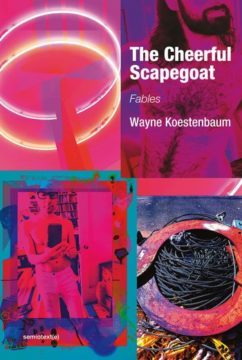Negar Azimi at Bookforum:
 IN THE ANTIC TALE that opens The Cheerful Scapegoat, Wayne Koestenbaum’s book of self-described “fables,” a woman named Crocus, like the flower, arrives at a house party wearing a checkered frock designed by the Abstract Expressionist Adolph Gottlieb. She cowers in the entrance, vacillating over whether to enter or not. She phones her doctor, a man whom she refers to as the “miscreant-confessor,” who entreats her to be social. Inside, Crocus accompanies a “fashionable mortician” to a bedroom where she happens upon a fully clothed woman lying atop a fully clothed man. Observing something “unformed and infantile” about the man’s features, Crocus is overcome by a feeling of revulsion, “as if she were looking at a Chardin painting for the first time and were not comprehending her ecstasy—a conundrum which forced Crocus to shove her rapture into a different medicine-cabinet, a hiding-place christened ‘Disgust.’” From this point on, any attempt to pithily encapsulate what happens is doomed.
IN THE ANTIC TALE that opens The Cheerful Scapegoat, Wayne Koestenbaum’s book of self-described “fables,” a woman named Crocus, like the flower, arrives at a house party wearing a checkered frock designed by the Abstract Expressionist Adolph Gottlieb. She cowers in the entrance, vacillating over whether to enter or not. She phones her doctor, a man whom she refers to as the “miscreant-confessor,” who entreats her to be social. Inside, Crocus accompanies a “fashionable mortician” to a bedroom where she happens upon a fully clothed woman lying atop a fully clothed man. Observing something “unformed and infantile” about the man’s features, Crocus is overcome by a feeling of revulsion, “as if she were looking at a Chardin painting for the first time and were not comprehending her ecstasy—a conundrum which forced Crocus to shove her rapture into a different medicine-cabinet, a hiding-place christened ‘Disgust.’” From this point on, any attempt to pithily encapsulate what happens is doomed.
more here.
